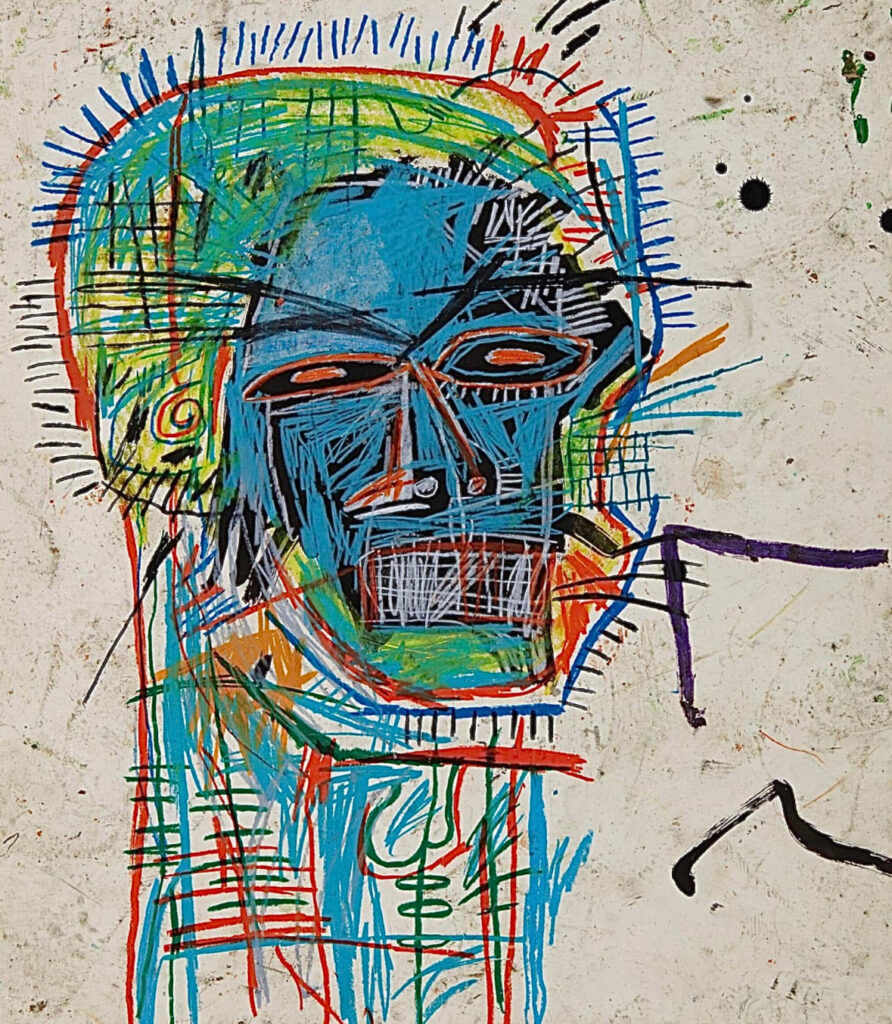Jean-Michel Basquiat, one of the most influential artists of the 20th century, redefined contemporary art with his bold, raw, and expressive works. A pioneer of the Neo-Expressionism movement, Basquiat seamlessly blended elements of street art, symbolism, text, and abstraction to convey powerful narratives about race, identity, social injustice, and the human condition. His 1982 drawing Untitled (Head) is a striking example of his artistic vision, encapsulating his distinctive style and thematic concerns.
At first glance, Untitled (Head) appears to be a simple yet intense depiction of a human face. However, upon closer inspection, it reveals a profound psychological depth, infused with raw emotion, existential questions, and cultural references. The drawing, which sold for $15.2 million at Sotheby’s in 2020, remains one of Basquiat’s most compelling explorations of the human experience, identity, and inner turmoil.
Basquiat’s Artistic Approach: A Fusion of Chaos and Control
Jean-Michel Basquiat’s artistic journey began in the streets of New York City, where he gained recognition under the pseudonym SAMO. His graffiti-based works, created in collaboration with fellow artist Al Diaz, carried cryptic messages and social critiques. As he transitioned from street art to fine art, he retained his signature raw energy and spontaneous execution, which became the defining features of his work.
In Untitled (Head), we see Basquiat’s mastery of line, form, and color at its finest. The head—central to the composition—is fragmented yet deeply expressive, rendered with frenetic, almost chaotic strokes that seem to pulse with intensity. The overlapping lines and bold use of contrasting tones create a sense of movement, as if the figure is vibrating with energy or caught in a moment of introspective tension.
Despite the seemingly free-flowing nature of the piece, Basquiat’s control over composition and expression is unmistakable. His deliberate placement of details, the raw expressiveness of the lines, and his careful balancing of negative space and visual elements demonstrate his intuitive yet highly sophisticated artistic process.
The Human Face as a Vessel of Emotion
Basquiat frequently returned to the human figure as a recurring motif in his work. Whether portraying kings, warriors, or abstracted figures, his approach to portraiture was anything but conventional. Rather than aiming for anatomical accuracy, Basquiat used the face as a psychological battleground, stripping away superficiality to reveal the raw essence of his subjects.
In Untitled (Head), the figure’s gaze is penetrating and almost unsettling, as if challenging the viewer to engage with its inner turmoil. The exaggerated facial features—particularly the eyes and teeth—seem to express a complex mix of fear, aggression, defiance, and vulnerability. The intensity of the lines, along with the layered textures and energetic strokes, reinforces the emotional weight of the piece.
Basquiat’s depiction of heads and skulls often carried deeper symbolic meaning. Heads represented knowledge, identity, and consciousness, while skulls were sometimes interpreted as a reflection on mortality and the transience of life. This thematic exploration was influenced by his Caribbean heritage, fascination with anatomy, and the imagery found in medical textbooks he studied as a child.
Text, Symbolism, and the Power of Language
A key characteristic of Basquiat’s work is his use of text, symbols, and abstract forms to construct layered meanings. While Untitled (Head) does not feature explicit textual elements, it embodies his unique approach to visual language, where every mark and line conveys a sense of urgency and meaning.
Basquiat often incorporated enigmatic symbols, scribbled words, and fragmented phrases into his paintings and drawings. These elements functioned as both personal expressions and social commentaries, touching on themes such as race, colonial history, power structures, and cultural heritage. Even in pieces without direct text, like Untitled (Head), his mark-making technique mimics the energy and spontaneity of written graffiti, turning the composition into an intricate visual dialogue.
The background of Untitled (Head), filled with abstract forms and expressive lines, suggests a deeper narrative beyond the face itself. It reinforces the idea that identity is multifaceted and layered, shaped by personal, historical, and cultural influences.
1982: A Pivotal Year in Basquiat’s Career
The year 1982 was a turning point in Basquiat’s career. It marked his rise to international acclaim, with solo exhibitions across major galleries in New York, Los Angeles, and Europe. During this period, his style became more refined yet remained intensely expressive, with works that combined his street-art roots with formal painting techniques.
Some of Basquiat’s most iconic pieces were created in 1982, including:
• Untitled (Skull) – A raw and visceral depiction of a distorted skull, symbolizing mortality, identity, and struggle.
• Boy and Dog in a Johnnypump – A vibrant, chaotic composition capturing the energy of urban life and racial identity.
• Untitled (Head) – A deeply personal exploration of the self, emotion, and human expression.
The common thread among these works is Basquiat’s relentless exploration of human nature—his ability to strip down his subjects to their core essence, raw emotion, and lived experience.
The Legacy and Market Value of Untitled (Head)
Basquiat’s work has consistently shattered records in the art market, reflecting his enduring influence and cultural significance.
In June 2020, Untitled (Head) sold for $15.2 million at Sotheby’s, reaffirming Basquiat’s status as one of the most sought-after artists in contemporary art history. This staggering price reflects not only the rarity of his early works but also the increasing recognition of his contributions to modern art, Black identity, and social commentary.
His record-breaking 2017 sale of Untitled (1982) for $110.5 million further cemented his position as one of the most valuable and impactful artists of all time.
The market value of his work is driven by:
His pioneering artistic style – A fusion of expressionism, street art, and social critique.
historical and cultural impression – A powerful voice in Black identity, race relations, and political discourse.
The rarity of his early works – Pieces from 1981-1983 are particularly coveted.
Untitled (Head) remains a testament to Basquiat’s genius, encapsulating his ability to convey raw emotion and psychological depth with just a few strokes.
Jean-Michel Basquiat’s Untitled (Head) is more than just a drawing—it is a window into the artist’s soul, a reflection of the human experience, and a pivotal moment in contemporary art history. Through its expressive intensity, psychological depth, and symbolic complexity, it speaks to themes of identity, emotion, and the nature of artistic expression.
Basquiat’s ability to transform simple forms into profound visual narratives continues to inspire generations of artists, collectors, and scholars. His work remains as relevant today as it was in the 1980s, serving as a powerful reminder of the intersection between art, culture, and social consciousness.
In a world where art often seeks to beautify or idealize, Untitled (Head) does the opposite—it confronts, challenges, and reveals. And in doing so, it ensures that Basquiat’s legacy as one of the most important and revolutionary artists of our time remains undeniable.
No comments yet.








